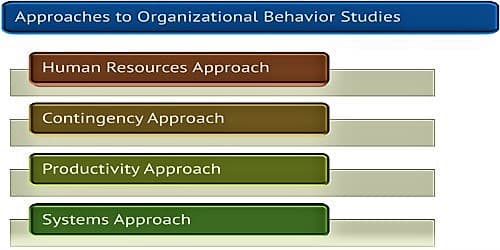Organizational Behavior is the study of human behavior in organizations. Organizational Behavior relates to the connection between employees and the owner in an organization. This study includes areas of research devoted to improving job performance, increasing job pleasure, promoting modernism, and encouraging leadership.
There are 4 basic approaches to the study of organizational behavior:
- Human Resources Approach
People are the greatest asset of any They are the central subsystem and resource of an organization, this approach is concerned with the growth and development of people towards higher levels of competency, certainty, and fulfillment. This approach recognizes the fact that people are the central resource in any organization and that they should be developed towards higher levels of aptitude, inspiration, and accomplishment. It assumes that increased capabilities and expanded opportunities for people will lead to the improvement of organizational effectiveness and efficiency. Their development will contribute to the success of the organization.
In the human resources approach, the role of managers changes from structuring and controlling to supporting. This approach recognizes that human resources in an institute are an essential force. Human resources approach provides for the changes in administrative responsibility. It requires that the managers, instead of controlling the employees, should provide dynamic support to them by treating them as part of the group.
- Contingency Approach
The contingency approach stresses that there is no particular way to administer efficiently under all situation. This approach is also referred to as ‘situational approach’ a technique that works in one situation will not necessarily work in all cases. Hence managers have to identify the technique which will best contribute to the attainment of the management’s goal in a particular situation, under particular circumstances and at a particular time. This approach also sometimes called the situational approach is based on the principle that methods or behaviors which work efficiently in one circumstance fail in another. This method discourages habitual practices of universal assumptions about methods and people.
For example; Organization Development (OD) programs, way work luminously in one situation but fail despondently in other circumstances. The methods of behaviors which work efficiently in one condition might fail in another.
The contingency approach is also more interdisciplinary, more system – oriented and more research-oriented titan any other approach. The organizational structure and the processes of management are governed by the exterior environment and numerous aspects of the internal environment.
- Human Relations Approach
Organizations should be viewed as a social system with economic and social dimensions. The work environment should be conducive to the restoration of man’s dignity. The Humanistic approach is based on the following assumptions:
- The organization is a system designed to produce a product or a service at a reasonable price.
- The organization is a social system through which the individuals try to find expression for their needs, goals, and aspirations. Hence the basic model for this approach should be employer participation, job satisfaction and increased productivity.
Productivity which is the ratio of output to input is the determination of an organization’s efficiency. It also reveals the manager’s competence in optimizing resource operation. For example, if better organizational behavior can decrease worker’s turnover or the number of absentees, a human output or advantage occurs.
- Systems Approach
The Systems approach Organizational Behavior views an organization as a unified, powerful system composed of interrelated parts. The activity of any segment of an organization affects in different degrees the activity of another segment. This approach gives managers a way of looking at the organization as an intact, whole, person, whole group, and the whole social system.
According to this approach, an organization receives numerous inputs from its environment such as material, human and financial. These inputs are then processed so as to produce the final output in terms of products or services.
These 4 behavioral approaches facilitate understanding of organizational behavior.













